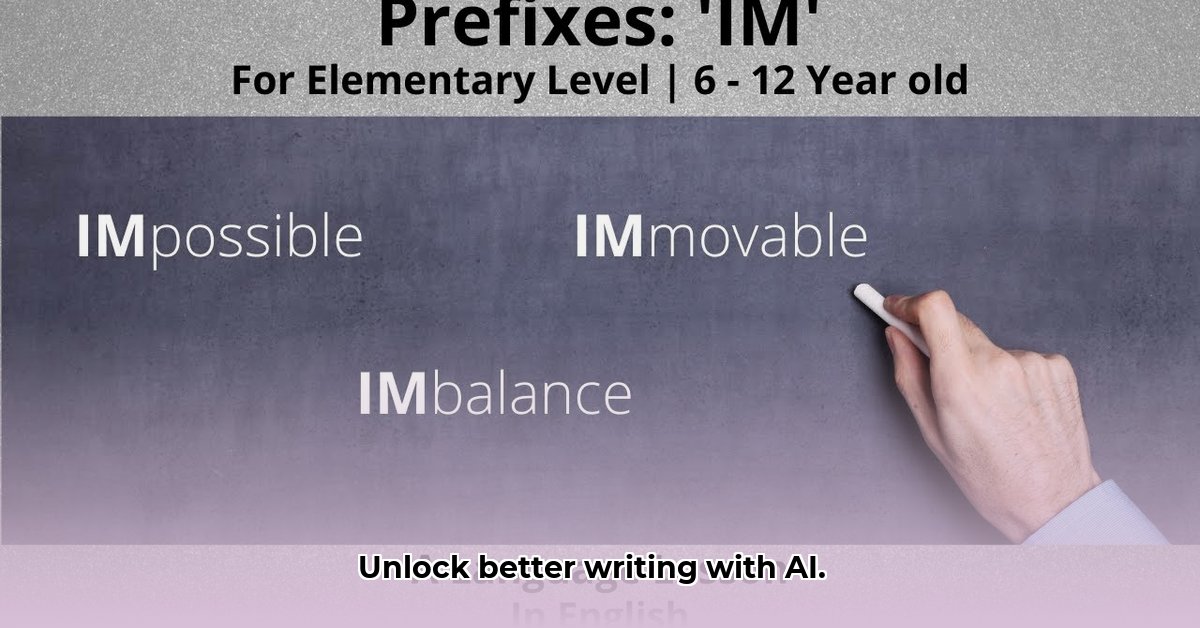
Unleashing the Power of AI Writing Tools: Ahrefs and Grammarly Compared
Writing well takes time and effort. However, AI writing tools can significantly boost clarity and engagement. For more word options, check out this helpful list of words starting with "im". This article compares two popular options: Ahrefs' Sentence Rewriter and Grammarly's Paragraph Rewriter, offering a detailed review and practical instructions for effective and ethical use. Both tools leverage artificial intelligence to enhance your writing, but they serve different needs and writing styles.
Key Takeaways:
- AI writing tools offer significant improvements in writing speed and quality.
- Ahrefs excels in quick edits of short-form content, while Grammarly is better suited for longer pieces requiring in-depth revisions.
- Ethical considerations, including plagiarism and bias, must always be at the forefront when using AI writing tools.
Ahrefs Sentence Rewriter: Quick Edits for Short-Form Content
Ahrefs' Sentence Rewriter is ideal for swiftly polishing social media posts, short blog snippets, or any text needing a readability boost. It's designed for refining individual sentences, making them more concise and impactful.
How to Use Ahrefs Sentence Rewriter:
- Copy and paste: Paste your text into the Ahrefs tool.
- Select your target: Highlight the sentence to improve.
- Hit "Rewrite": Click the rewrite button.
- Choose the best option: Select the rewritten sentence that best fits your style.
Pros:
- Speed and Simplicity: Extremely user-friendly and fast, perfect for quick edits.
- Social Media Optimization: Excels at enhancing social media posts.
- Clarity Enhancement: Effectively improves sentence structure and flow.
Cons:
- Limited Scope: Only rewrites individual sentences, not entire paragraphs.
- No Plagiarism Check: Requires a separate plagiarism checker.
- Basic Feature Set: Fewer features compared to more comprehensive tools.
Grammarly Paragraph Rewriter: Comprehensive Prose Polishing
Grammarly's Paragraph Rewriter is a powerful tool for longer texts like essays, reports, or chapters. It polishes language and checks for plagiarism, acting like a skilled editor.
How to Use Grammarly's Paragraph Rewriter:
- Paste your paragraph: Enter the text into Grammarly.
- Select "Rewrite": Locate the rewrite feature in Grammarly's interface.
- Review suggestions: Grammarly provides rewrite options.
- Refine and adjust: Choose a version and further refine tone and style.
Pros:
- Paragraph-Level Capabilities: Handles entire paragraphs for substantial improvements.
- Plagiarism Detection: Includes a built-in plagiarism checker.
- Style Control: Allows customization of tone and style.
- Vocabulary Enhancement: Suggests stronger vocabulary.
Cons:
- Steeper Learning Curve: Requires more time to learn all features.
- Subscription Required: Full access often requires a subscription.
- Less Efficient for Short Content: Not as efficient for quick edits of short posts.
Ahrefs vs. Grammarly: A Detailed Comparison
| Feature | Ahrefs Sentence Rewriter | Grammarly Paragraph Rewriter |
|---|---|---|
| Focus | Sentence-level refinement | Paragraph-level improvement |
| Best For | Short-form content, quick edits | Longer documents, in-depth revisions |
| Key Strengths | Speed, ease of use | Comprehensive rewriting, plagiarism detection |
| Key Weaknesses | Limited scope, lacks plagiarism detection | Subscription required, steeper learning curve |
Ethical Considerations: Responsible Use of AI Writing Tools
AI tools are assistants, not replacements for your writing skills. Over-reliance can hinder personal growth. Always review and edit AI suggestions to ensure authenticity and avoid plagiarism. Proper attribution is critical. Responsible use ensures ethical and effective communication. The goal is to write authentically and impactfully. Furthermore, be aware of potential biases in AI-generated text and always fact-check.
How to Ethically Use AI Rewriting Tools in Academic Writing: A Step-by-Step Guide
- Clarify your task: Define your writing goals and the specific AI assistance needed.
- Choose your tool: Select an appropriate tool aligning with your ethical principles.
- Input and review: Provide clear instructions and critically analyze the AI's output.
- Refine and rewrite: Don't simply accept AI suggestions; rewrite and synthesize them with your own ideas.
- Cite and disclose: Clearly state your use of AI tools in your work's methodology section or similar.
Remember, AI tools enhance, they don't replace, critical thinking and original thought. Always prioritize academic integrity and responsible usage.